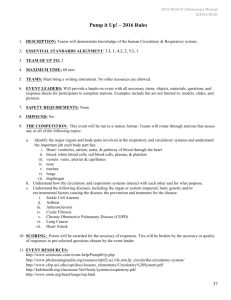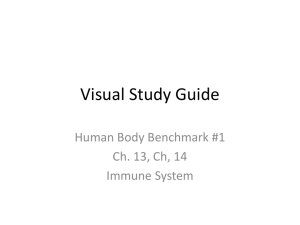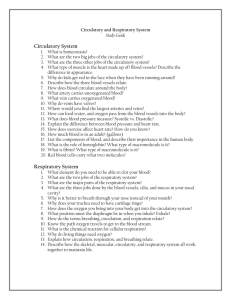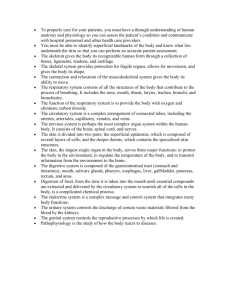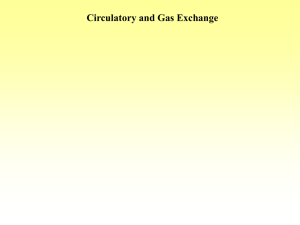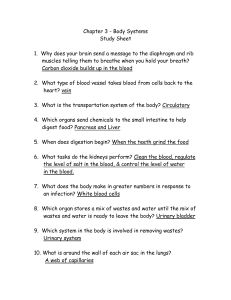Physiology 3
advertisement
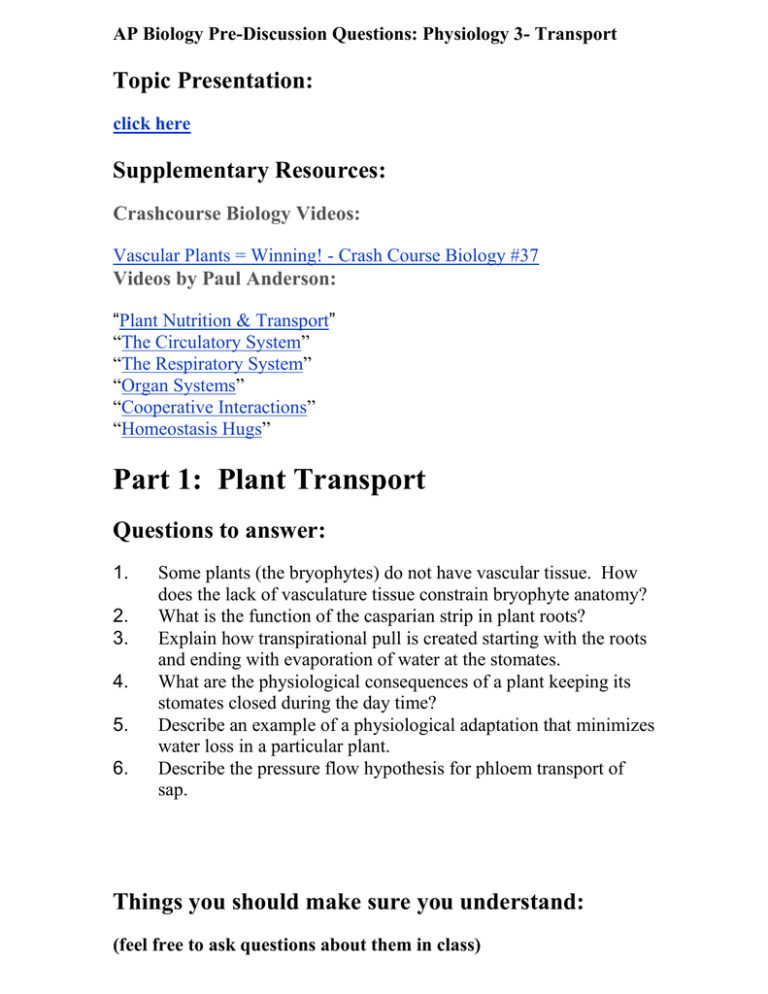
AP Biology Pre-Discussion Questions: Physiology 3- Transport Topic Presentation: click here Supplementary Resources: Crashcourse Biology Videos: Vascular Plants = Winning! - Crash Course Biology #37 Videos by Paul Anderson: “Plant Nutrition & Transport” “The Circulatory System” “The Respiratory System” “Organ Systems” “Cooperative Interactions” “Homeostasis Hugs” Part 1: Plant Transport Questions to answer: 1. 2. 3. 4. 5. 6. Some plants (the bryophytes) do not have vascular tissue. How does the lack of vasculature tissue constrain bryophyte anatomy? What is the function of the casparian strip in plant roots? Explain how transpirational pull is created starting with the roots and ending with evaporation of water at the stomates. What are the physiological consequences of a plant keeping its stomates closed during the day time? Describe an example of a physiological adaptation that minimizes water loss in a particular plant. Describe the pressure flow hypothesis for phloem transport of sap. Things you should make sure you understand: (feel free to ask questions about them in class) •. How the processes of plant transport depend upon water potential and how that water potential is generated as a function of pressure and solute concentration. •. The consequences of adaptations that minimize water loss on plant physiology. Part 2: Animal Transport (Circulation) Questions to answer: 1. 2. 3. 4. 5. 6. 7. What are the trends that are seen in animal circulatory systems over evolutionary time? Compare the open circulatory system of arthropods with the closed circulatory systems of vertebrates. Why has evolution resulted in the development of a 4-chambered heart in two distinct lineages? Explain how the components of blood allow for the various functions of blood. Compare arteries, capillaries and veins. Diagram the path that blood flows through the mammalian body. Include all four chambers of the heart, and all arteries and veins that lead immediately to and from the heart. Indicate where blood is the most oxygenated, and where it is the least oxygenated. Explain how heart beat is regulated in the mammalian heart, and how that heartbeat relates to blood pressure. Things you should make sure you understand: (feel free to ask questions about them in class) •. The consequences of particular evolutionary trends in circulatory systems for the organisms that demonstrate those trends. •. The structure and function of all parts of the mammalian circulatory system. •. How the components of the circulatory system work with other body systems to maintain homeostasis. •. How the circulatory system is regulated. •. The causes, effects, and treatments of various circulatory system disorders. Part 3: Animal Transport (Gas Exchange) Questions to answer: 1. 2. 3. 4. 5. 6. 7. 8. Why do animals need specialized systems to exchange gasses with the environment? What are the characteristics of a functional respiratory surface? Diagram the countercurrent exchange system of a fish gill, and explain how it maximizes diffusion of respiratory gasses. Why are capillaries required for gas exchange? Diagram an alveolus to show blood flow, air flow, and oxygenation of both. Compare how oxygen and carbon dioxide are transported in the bloodstream. What happens to hemoglobin in conditions of low pH? Why is this adaptive for mammals? How is breathing controlled by the nervous system in mammals? Things you should make sure you understand: (feel free to ask questions about them in class) •. The consequences of particular evolutionary trends in respiratory systems for the organisms that demonstrate those trends. •. The structure and function of all parts of the mammalian respiratory system. •. How the components of the respiratory system work with other body systems to maintain homeostasis. •. How the respiratory system is regulated. •. The causes, effects, and treatments of various respiratory system disorders.
